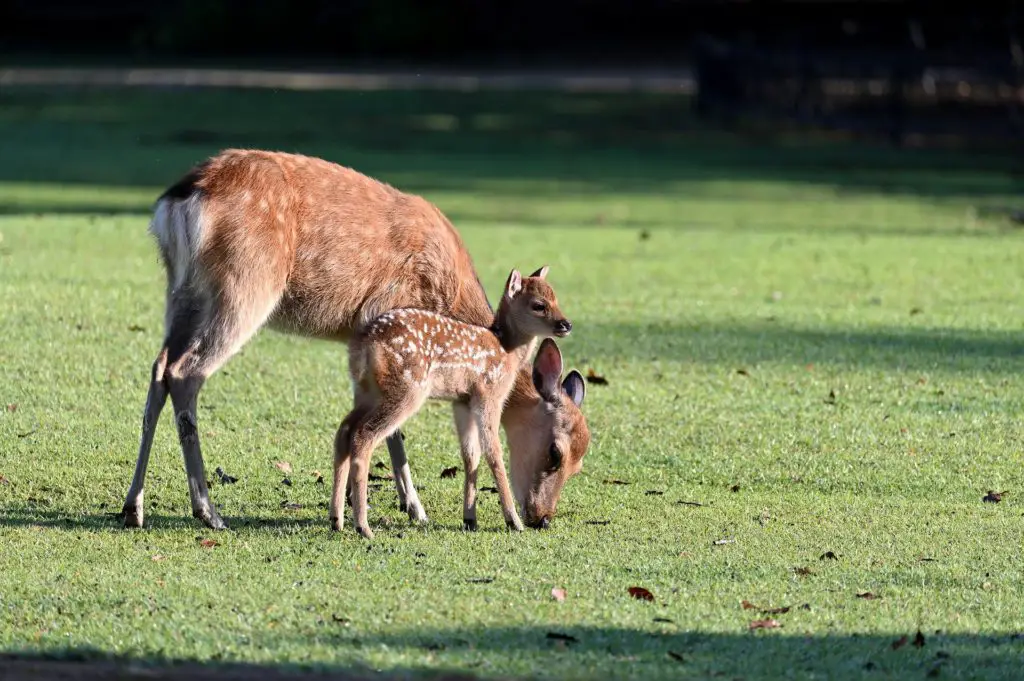Our kitchen has large windows overlooking the yard, so we tend to see much of what happens outdoors throughout the day as we cook, eat, or pack kids’ lunches. If we find ourselves staring outside for at least 20 seconds, we are certain to see some type of animal scurrying across the lawn. Typically it’s one of the members of a large chipmunk clan who has burrowed into our retaining walls. Often it’s squirrels or rabbits, and in the quiet, wee hours, there are deer. What are they doing in the midst of all that grass? Are they eating it?
Which Common Yard Animals Eat Grass?
Most herbivores eat grass. There is plenty of manicured grass in the suburbs, and no cows, horses, sheep, and other pasture animals to gobble it up. In this setting, the animals that eat grass are deer, rabbits, squirrels, raccoons, opossum, and chipmunks. However, grass is by no means the favorite meal of the suburban wildlife in my yard. Deer, squirrels, rabbits, and chipmunks would rather eat plants with higher nutritious value than grass. Unfortunately for us humans, this often means ornamental, leafy plants including hostas, roses, peonies, or garden vegetables.

To deter suburban wildlife from eating your grass, it’s important to know what kind of animal you are dealing with. The summary below will help you identify the animals eating or digging your grass.
- Deer tend to take larger bites and, in my yard, leave large dead patches of grass from urination.
- Squirrels, chipmunks, and other small rodents typically leave tiny holes from burying nuts, seeds, or from foraging around the base of the blades of grass.
- Raccoons and skunks dig up the grass in large, messy clumps in search of food.
- Rabbits eat loads of grass and it’s an important part of their diet. We see lots of rabbits in our yard but their eating habits have never caused a problem for our grass.
- Moles dig small holes (1-2 inches in diameter) in the lawn, and also chew the roots of our bushes and ornamental plants, which causes damage (if you look closely at the roots of damaged plants, you may be able to spot signs of their tiny teeth). Another telltale sign of moles is small mounds of dirt next to the hole. They eat lots of insects, so the damage to your lawn from moles is largely cosmetic.
- Groundhogs dig larger holes (5-6 inches in diameter) which can make it hard to maintain a healthy lawn if the holes are plentiful.
How Can I Prevent Animals from Digging Holes in My Yard?
I have found it nearly impossible to keep all suburban wildlife out of my yard, but there are many ways to minimize their damage and deter them from digging your grass.
It is typically pretty easy to determine how the burrowing animals, like groundhogs and moles, are getting into the yard by looking for the entrance to their tunnels. Many gardeners and homeowners have success with using household items with a strong smell to repel them, such as garlic powder or crushed cloves, or even coffee grounds. I don’t find the small holes (up to two inches in diameter) to be a big problem for grass growth. The larger holes that groundhogs dig are more damaging and can make the entire surface of the lawn uneven and create challenges for mowing. Laying a ground cloth over some of the areas with the most holes will deter them by making it harder to dig tunnels.
For animals that do not burrow, but dig grass in clumps in search of food (chipmunks, squirrels, raccoons, or skunks), there are commercially available sprays and powders that can be sprinkled on your lawn to deter them. Typically their holes will not harm your lawn. Many pest deterrent sprays are ammonia based. This means that when you are using them on grass, you must be sure not to overapply, which could lead to “fertilizer burn” on your lawn.
Holes from moles are largely a cosmetic concern, as the moles are primarily carnivorous and not interested in eating your grass. Simply tamp down the holes when you spot them.
Do Animals Prefer Grass Seed to Grass?
You may notice after applying fresh seed how many more animals gather in your yard. Seeds contain more nutrients than blades of grass and are easy to obtain when sprinkled on your lawn, so squirrels, chipmunks, and other furry critters seem to prefer grass seed or newly sprouted grass to eating a fully grown lawn. As you may guess, birds also want in on the action.
Animals eating my grass seed have never completely stopped my grass from growing. Even the rabbits, who seem to enjoy the grass the most of all the wildlife in my neighborhood, haven’t damaged our lawn by snacking there.
A more persistent problem in our lawn is the holes dug by suburban wildlife, like moles, opossums, squirrels, chipmunks, and groundhogs as they burrow or forage for grubs and other food under the grassy layer.
How Can I Prevent Animals from Eating My Grass Seed?
There are a few methods for protecting your grass seed from animals during the early weeks of grass growth:
- Install a bird feeder to provide another source of seeds for birds, chipmunks, and squirrels.
- Use deterrents like motion activated water sprinklers.
- Stake a decoy in the lawn while seeds are getting established, such as mylar balloons or lawn ornaments that spin and whirl, as the movement and moving shadows scare animals away.
- Spread straw across the newly seeded surface. In my experience, squirrels and other rodents can and will dig under the straw to get to the seed; however, the straw will be a deterrent.
You can also spread bird netting or a thin mesh sheet across your lawn. This surface allows sufficient light to penetrate to the seeds so that it can deter birds without stifling the seeds’ growth. In my experience, that last method seems a little extreme.
